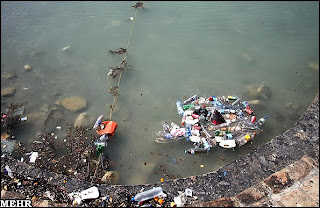Iran in fighting with Caspian Sea pollution

Iran, with its largest population on the Caspian Sea shore among other littoral countries, is keen to save the world's biggest inland body of water from pollution and has initiated a "Comprehensive plan to reduce pollution" plan.
The Fars News Agency quoted the head of Department of Environment Mohammad-Javad Mohammadzadeh as saying that the plan targets preventing entry of pollutants, including household waste, especially in Gorgan and Mazandaran provinces, to the Caspian.
Meanwhile, Abdolreza Karbasi, the deputy head of Environmental Protection of Iran alarmed about the ecological state of beaches, releasing warning to swimmers in the Caspian Sea. "The pollution at some parts of the sea has exceeded the authorized limit by 100 times," he said.
Iranian coastal population is around 6 million people, including residents in the regions en route the rivers that flow to the Caspian, whose household waste waters enter the sea without passing through water purification devices.
The Caspian Sea ecology is of concern of each littoral countries.
A convention on Protection of the Marine Environment of the Caspian Sea (Tehran Convention) undersigned by the heads of Iran, Russia, Kazakhstan, Azerbaijan and Turkmenistan in 2003 definitely outlines the commitments of the sides for securing the Caspian environment.
According to the Tehran Convention, all Caspian Sea littoral countries are committed to take all necessary measures, individually or collectively, to reduce and control pollution of the sea.
However, enforcing the document is still debatable, especially protecting the exhausting marine species, like sturgeon is a topic of hot discussions.
All of the species of sturgeon in the Caspian Sea, one of the oldest families of fishes in existence with estimated 250 million years old, valued around the world for their precious roe, are at risk of extinction, making them the most threatened group of animals on (the International Union for Conservation of Nature) the IUCN Red List of Threatened Species.
Sharp decrease in caviar production from the Caspian is alarming. For instance, production of this lovely delicacy was only 100 tons in 2010 compared to 3,000 tons in 1985.
Pollution has damaged other marine species as well. The population of sprats has decreased 10 times during recent decades, the Caspian Seal population is currently estimated to be around 100,000 -- less than 10 percent of what it was a century ago. The first mass deaths of seals especially in resource-rich Mangystau sea port, Khazakhstan, took place in 2000. Over 330 seals died in 2006, reportedly from a virus, than almost 1,000 in 2007 and over 350 in 2009 and some others have been killed in May 2011 as well.
The humanity may be in turn of species in danger after sprats, estrogens, seals and other species of the Caspian Sea soon. It's alarming...

Comments
Post a Comment